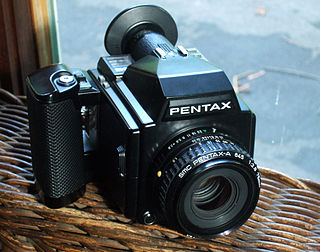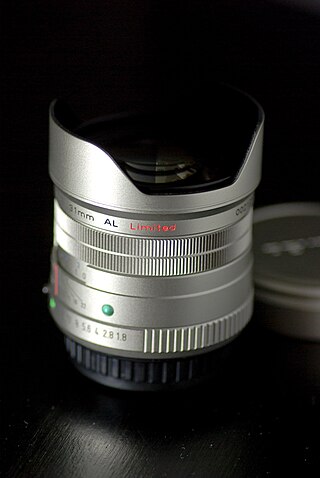
The Pentax Auto 110 and Pentax Auto 110 Super were fully automatic single-lens reflex cameras manufactured by Asahi Pentax for use with Kodak 110 film cartridges. The Auto 110 was introduced with three interchangeable, fixed focal length lenses in 1978. A further three lenses were added in 1981 to coincide with the release of the Auto 110 Super the following year. The camera system was sold until 1985. The complete system is sometimes known as the Pentax System 10, apparently for its official Pentax name, although most Pentax advertising only uses the camera name or Pentax-110. This model represented the only complete ultraminiature SLR system manufactured for the 110 film format, although several fixed-lens 110 SLRs were sold. The camera system also claims to be the smallest interchangeable-lens SLR system ever created.

Takumar is the name that Asahi Optical gave to its lenses, notably but not exclusively those for its own SLR cameras. Named after the Japanese-American portrait painter, Takuma Kajiwara, whose brother Kumao Kajiwara founded Asahi Optical. The name adorned its lenses until 1975, when Asahi switched from the M42 screw mount to the bayonet K-mount. K-mount lenses were simply named "SMC Pentax". Some Takumar lenses were also made for the K-mount.

The Pentax K1000 is an interchangeable lens, 35 mm film, single-lens reflex (SLR) camera, manufactured by Asahi Optical Co., Ltd. from 1976 to 1997, originally in Japan. The K1000's extraordinary longevity makes it a historically significant camera. The K1000's inexpensive simplicity was a great virtue and earned it an unrivalled popularity as a basic but sturdy workhorse. The Pentax K1000 eventually sold over three million units.

The Pentax MX was a 35 mm single-lens reflex camera produced by Asahi Optical Co, later Pentax of Japan between 1976 and 1985. It was Pentax's flagship professional SLR until the introduction of the Pentax LX. Internally, the MX is essentially a smaller, lighter version of the Pentax KX, and otherwise has little in common with the rest of the Pentax M-series. However, the MX was designed as the mechanical twin sister of the remarkably successful entry-level Pentax ME.

The Pentax K-mount, sometimes referred to as the "PK-mount", is a bayonet lens mount standard for mounting interchangeable photographic lenses to 35 mm single-lens reflex (SLR) cameras. It was created by Pentax in 1975, and has since been used by all Pentax 35 mm and digital SLRs and also the MILC Pentax K-01. A number of other manufacturers have also produced many K-mount lenses and K-mount cameras.

The EF 85mm lenses are a group of medium telephoto prime lenses made by Canon Inc. that share the same focal length. These lenses have an EF type mount that fits the Canon EOS line of cameras.

Lens speed refers to the maximum aperture diameter, or minimum f-number, of a photographic lens. A lens with a larger than average maximum aperture is called a "fast lens" because it can achieve the same exposure as an average lens with a faster shutter speed. Conversely, a smaller maximum aperture is "slow" because it delivers less light intensity and requires a slower (longer) shutter speed.

The Pentax ME F was an amateur level, interchangeable lens, 35 mm film, single-lens reflex (SLR) camera. It was manufactured by Asahi Optical Co., Ltd. of Japan from November 1981 to 1984. The ME F was a heavily modified version of the Pentax ME-Super, and a member of the Pentax M-series family of SLRs. It was the first mass-produced SLR camera to come with an autofocus system.
This article discusses the cameras – mainly 35 mm SLRs – manufactured by Pentax Ricoh Imaging Corp. and its predecessors, Pentax Corporation and Asahi Optical Co., Ltd.. Pentax must not be confused with Pentax 6x7 or Pentax 67 which are 120 medium format 6x7cm film cameras.

Pentax lenses were first badged as Takumar. The Takumar branded lenses were well respected for their line of Super Takumar, which designated the high performance coating applied to the lens as well as the optical formulas used to make them. The majority of the industry at the time was still satisfied with the variations of the "plumb" coating process and later some of the two and three layer processes as well. Asahi Pentax soon introduced the Takumar Super-Multi-Coated line of lenses which was a 7 layer process as the industry had just caught up with similar forms of 5 layer multi-coated optics. Eventually Asahi Optical and Pentax slowly shifted much of their lens production under the Pentax name and transitioned some of the successful designs that were first introduced under the Takumar name to use Asahi/Pentax badging as well as beginning to use the "smc" abbreviation. Eventually the Asahi partnership disappeared and the Pentax name became solely used. Pentax lenses saw many feature changes to answer the market, such as: incorporating "Auto-Aperture" with the M42, the light weight and compactness with the 'M' series, Aperture Priority overrides with the 'A' series, and Auto-Focus with the 'F' series. Modern Pentax lenses for digital SLR cameras have seen the elimination of the aperture ring completely as found on Pentax DA and D-FA series lenses. They use the Pentax KAF mount. All of these lenses have an autofocus feature, either operated from the camera body or from an internal SDM motor. Pentax compatible lenses are also made by third-party companies.

The Fujifilm X-mount is a lens mount for Fujifilm interchangeable lens mirrorless cameras in its X-series, designed for 23.6mm x 15.6mm APS-C sensors.

The Pentax 645 is a medium format single-lens reflex system camera manufactured by Pentax. It was introduced in 1984, along with a complementary line of lenses. It captures images nominally 6 cm × 4.5 cm on 120, 220, and 70 mm film, though the actual size of the images is 56 mm × 41.5 mm.
The SMC Pentax-DA 50mm f/1.8 lens is a normal prime lens for the Pentax K-mount. The 75mm equivalent focal length on APS-C cameras and fast f/1.8 aperture make it well suited for portrait photography. It uses a simple double-Gauss design of 6 elements in 5 groups.

The SMC Pentax-FA 31mm f/1.8 AL Limited is a full-frame moderate wide-angle lens for Pentax K-mount. On an APS-C camera, it gives a normal field of view. It lacks Quick Shift Focus, which is now found on most other Pentax lenses, and therefore does not allow manual focusing while in autofocus mode.
Mr. Jun Hirakawa(平川純) is a Japanese lens designer best known for creating the Pentax FA 43mm Limited and FA 77mm Limited lenses during his time at Pentax.
The Pentax smc FA 43mm F1.9 Limited is a normal prime lens for Pentax K-mount. It has also been sold as an Leica S-mount version in Japan.

The HD Pentax-D FA* 50mm f/1.4 SDM AW lens is a professional normal prime lens for the Pentax K-mount. It was officially announced on October 27, 2017, launched on June 28, 2018, and first shipped on July 26, 2018.
The HD Pentax-D FA* 85mm f/1.4 SDM AW lens is a professional short telephoto prime lens for the Pentax K-mount. The lens was officially announced on February 26, 2019, launched on June 25, 2020 and announced to be first shipped on June 26, 2020.













